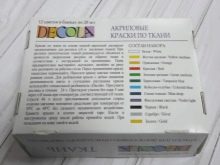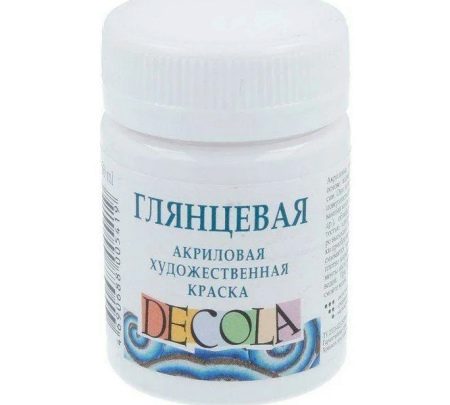Features of Decola fabric paints

A bright, beautiful pattern on clothes is a great way to highlight your style, make an item of clothing themed, or show your creativity. Many professional fabric designers choose the practical and inexpensive Decola paints for their designs on T-shirts, jeans and other wardrobe items. Beginners can also cope with such material, the main thing is to read the instructions for use and practice a little.


Advantages and disadvantages
Decola Acrylic Paints on Fabric is a widespread material that can be found in almost every art store. The use of such acrylic has both pluses and minuses, which you need to familiarize yourself with before starting drawing in order to avoid unpleasant surprises. Decola paints have the following advantages:
- large selection of shades;
- the consistency of the paint is thick and dense;
- high drying speed;
- different paint colors can be mixed and new shades can be obtained;
- the finished drawing does not peel off the fabric, retains color and can stretch slightly;
- low cost;
- lack of smell;
- the ability to buy both sets and individual colors.



The disadvantages of the material include the following nuances:
- poor covering ability of some shades - this can be compensated for by applying several layers or creating a white substrate;
- thickness of the pattern - if you apply too many layers, the pattern will weigh down the fabric and may deform the knitted material;
- stickiness - in the first two days, the surface of the pattern may be slightly sticky, however, after complete drying and ironing, this effect disappears;
- change in tone - after drying, acrylic becomes a little darker and brighter, so you need to take this into account before drawing.
Experienced fabric artists advise to always create a white backing - cover the area of the drawing with 1-2 layers of white paint, repeating the outline of the illustration.
If colored acrylic is applied directly to the fabric, its color will change greatly, which will require the artist to apply more layers to achieve the desired shade. On a white background, all paints will retain their color and be applied more evenly, because the substrate will smooth out the ribbing of the material.


Assortment overview
Acrylic paints for fabrics are sold in 50 ml jars, which can be purchased individually. The assortment of shades is very large, so you need to decide in advance what color you need. If you are just starting to paint, you can purchase a basic set of 6 colors - this amount of paints is enough to get started, in addition, if necessary, they can be mixed in a separate container. For aspiring artists, there is also a palette of 12 shades available, containing not only standard colors, but also some unusual shades.
The range of Decola paints is not limited to a wide variety of shades - art material can also have different effects. For example, you can find matte, glossy and pearlescent paints on store shelves.


Let's take a closer look at the varieties of Decola paint, depending on the effect.
- Matt. The most popular type of paint used for most drawings. The paint is applied in an even layer and does not shine after drying. This acrylic allows you to create both calm and very bright drawings with many interesting accents.


- Glossy. Glossy acrylic is used less often than matte, but it can help create equally impressive designs. After the artwork painted with glossy paint dries, its surface becomes shiny. The properties of matte and glossy acrylics do not differ - they both cover the fabric well, are bright and can stretch slightly after drying.

- Fluorescent. Thanks to this paint, an unusual type of material is obtained that glows under ultraviolet light. The palette of shades of such material is very large, so the drawing will look good not only under ultraviolet light, but also in daylight.

- Mother of pearl. Leaves fabric with a soft pearlescent sheen. The paint is available in a wide variety of shades and may interfere. Plain or monochrome designs are usually created from such acrylic. In some cases, they are used to paint stage or festive clothing.

- Contour. The only type of Decola paint not produced in a can, but in a tube with a spout. Convenient packaging is designed to create a thin outline. Used for sketching and preventing mixing of different colors. On sale there are both classic matte and glossy paints, as well as options with glitters.
All Decola acrylics are suitable for painting on cotton, silk and some synthetic fabrics.


How to use it correctly?
If you follow some simple rules, painting on fabric is no more difficult than on paper or canvas. However, drawing on clothes has several quirks that you need to be familiar with in advance. A simple step-by-step instruction will help you create a beautiful drawing on a wardrobe item.
- First, mark on the fabric where the pattern will be applied. - this is necessary in order to initially prevent skewing of the image and arrange it exactly as intended.

- Next, you need to fix the wardrobe item on a flat board, tablet or piece of cardboard. - this can be done with stationery clips or clothespins.It is important to remember that the tablet must be placed inside the product (between the shelf and the back), because during the drawing process, paint can pass through the fabric and be printed on the back of the product. It is impossible to wash the paint on the Decola fabric, so it is better to paint carefully and avoid mistakes.
Wrap the tablet in plastic wrap to prevent leaked paint from sticking to the surface. If the fabric is stretching, do not pull too hard on the tablet, as this will fix the fabric in the stretched position.



- Draw a chalk sketch at the designated location., soap or special disappearing marker. If necessary, you can use a carbon copy or stencil.


- At this point, paint can be started. This can be done in two ways - with a brush or a sponge through a stencil. Remember to first create a white backing to preserve color and apply color only after it dries. The only exceptions are perfectly white things - no backing is needed to paint them. Each new layer must be painted only after the previous one has dried.


- After drying, iron the patternby placing a cotton cloth over the drawing and inside the clothes, where the tablet was previously. The pattern should be ironed for about 5 minutes at a temperature suitable for the fabric.


- After ironing, the product with a pattern must be left in a straightened position for 1-2 days, and then wash it by hand or in a typewriter on a gentle mode. When spinning by hand, try not to squeeze the place of the pattern, so as not to damage its integrity.
Decola is sold ready-to-use - it does not need to be thinned with water or thinner. Nevertheless, there are special solvents for acrylic on the market, but they are designed to reduce the saturation of the shades, and not to dissolve the paint.









